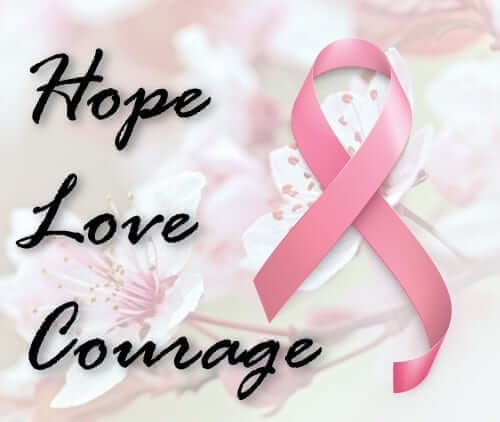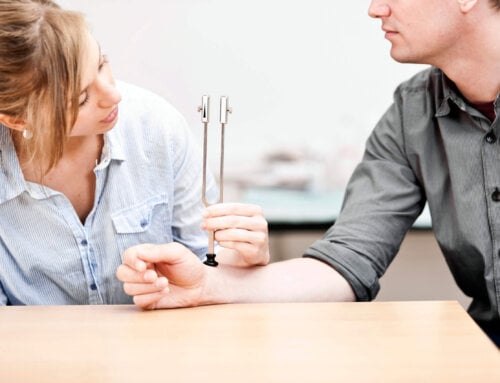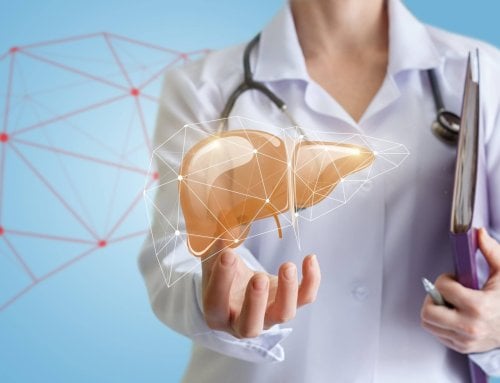Since it is October and Breast Cancer Awareness Month, I have decided to share some information with you that is indirectly related to diabetes. Current research has suggested that there is a connection between cancer and diabetes. Although breast cancer is not as common in people with diabetes as colon, bladder, liver, pancreatic and endometrial cancer, it seems appropriate to talk about it this month. The research connects hyperglycemia (high blood sugar), hyperinsulinemia (high insulin level) inflammation and cancer cells feeding off sugar as the reasons for the diabetes/cancer connection. Research according to The American Institute for Cancer Research estimates that “healthy lifestyle habits could prevent 38 % of breast cancer cases diagnosed in the US yearly”. Let’s examine recent breast cancer information.
What causes breast cancer? Although it is not entirely clear; breast cancer is related to genetics, lifestyle, hormones and the environment. It is noted that only 5-10% of breast cancer is inherited. There are gene tests for those in high risk families which look for specific genes such as BRCA1 and BRAC2; these increase the risk for breast/ovarian cancer. The test is simple but expensive and requires swabbing your cheek for saliva; it may be covered by insurance. Working with a genetic counselor is an important step if your risk is high since many people do not want to know their future or are afraid of health/life insurance implications. Breast cancer occurs when breast cells grow abnormally and end up forming a mass or lump. Guidelines for breast cancer screening keep changing so it is important to talk to your health care provider and use your own situation to make final decisions about screening. At this point, most physicians suggest a baseline mammogram at age 40 unless there is a strong family history or other risk factors.
- What other risk factors are involved? The most common ones cited are older age, family history, previous self breast cancer history, being female, smoking or alcohol intake, sedentary lifestyle and obesity, starting your period prior to age 12, going through menopause after the average age (average is 52-53), having a first child after the age of 35 or never being pregnant. Men are not immune to breast cancer and there are 1% of cases noted in the US yearly; men should report any breast tissue pain or changes immediately.
- What about those at super high risk? You may want to talk to your physician about possible chemo-prevention therapy medications. These include Tamoxifen and Evista known as aromatase inhibitors which may lower your risk. There are side effects with these medications so always discuss the risks and benefits with your health care provider. Some patients request a prophylactic mastectomy with reconstruction as well as an oophorectomy (ovary removal) to lower their future cancer chances.
- What are the screenings? As mentioned before, always consult with your ob-gyn or internist to decide which screenings are best for you since as with all medicine, it is becoming more individualized. Start with the basic self breast exam once a month around the same time each month if you still menstruate. Be vigilant about any changes and report them to your doctor immediately. There is controversy about the accuracy of a self breast exam but it can never hurt you; you are most familiar with your own anatomy and often the one to identify changes or abnormalities. Follow with your yearly breast exam performed by your medical professional. The physician will check your breasts for lumps or irregularities as well as for enlarged lymph nodes in your armpits, skin puckering, nipple changes, drainage or change in skin color or temperature. A yearly mammogram or breast x ray is still suggested for those ages 40 or above. If there is a questionable result on your mammogram or you have dense/fibrous tissue (opposed to fatty breast tissue), your doctor may suggest an ultrasound. This uses sound waves to produce pictures of organs inside of the body and is performed by a special technician. It can differentiate between fluid cysts and solid masses. If these are abnormal an open or needle biopsy will be performed. A needle biopsy is performed by a radiologist with a guided x-ray noting the target area to be removed as compared to an open cut into the breast tissue looking for the actual lump. An MRI with and without dye contrast may also be performed. This uses magnets and radio waves to form pictures inside the breast. A phenomenon called interval cancer can occur between yearly screenings and can be especially aggressive so additional yearly testing may be done for those in this risk category.
- What are the treatments? Treatments are becoming much more patient specific and there really is no one way to treat breast cancer. Depending on the stage level, the physician, patient and team will decide if a lumpectomy, mastectomy or double mastectomy is appropriate. Lymph nodes will be examined for cancer cells and removed if necessary. Breast cancer surgery is often followed by radiation therapy which is high beam X-ray pointed at the area of cancer cell. Chemotherapy may be given in addition to target the specific cancer cells. It can be given in an IV out-patient setting or pills, depending on the situation. Drugs have become more specific and are now called targeted drugs. It is most important for you to find a team approach where they will treat you as an “entire person” with medical advances, mental/social support along with nutrition and exercise recommendations. Many patients join support groups for emotional support and connection which are offered through multiple organizations including the American Cancer Association. There are also cancer nurse navigators /coordinators who can now guide you through the entire process.
- What can I do to lower my breast cancer chances? Maintaining a healthy weight (as in diabetes) is especially important with a BMI in the range of 18.5-24.9%. Gaining more than 20 pounds after age 18 can impact your risk as well as being overweight after menopause. This can increase breast cancer risk up to 30-60 %. Weight gain increases diabetes risk as well.
- Exercise: As with diabetes, there is strong evidence that being physically active helps reduce breast cancer risk. Exercising 5 times a week with activities such as walking, swimming, biking, Zumba, dancing, jogging, and elliptical or a combination may lower breast cancer risk up to 30%.
- Quality eating: A new study published in JAMA- Journal of the American Medical Association states that “a diet heavy in virgin olive oil as in the Mediterranean diet may cut breast cancer risk by 62%”. 5,000 women were tracked for 5 years to establish this finding. Filling your plate with 1/2 to 2/3 of non-starchy vegetables, low glycemic fruits and lentils or beans (high quality carbohydrates with a lot of fiber) and 1/3 of lean protein may be the best for breast cancer prevention. Green tea, berries, red and black grapes (Resveratrol in the skins not the juice) and cruciferous vegetables such as cabbage, broccoli, cauliflower and Brussel sprouts should be included. Stay away from processed and bagged foods or foods with additives and artificial flavors and colors. These recommendations are familiar to people with diabetes as well.
- Alcohol: New studies have noted that any alcohol will increase breast cancer risk. If you do not drink, do not start. If you drink, stick to less than 7 drinks a week and no more than one per day. “Two or more alcoholic drinks a day can raise the risk to 51%”. Make sure to get folate in your diet through beans, leafy greens, fruits or take a supplement up to 400mcg per day. Folate is robbed when you drink alcohol and may make you more vulnerable to cancer.
- Grilling: Always marinate your meats first or precook at a lower temperature to prevent charring which will reduce the carcinogens. Steaming foods at a low temperature or slow crock pot cooking is a great option.
- Avoid hormone therapy in menopause: If you must take hormones, take them in the lowest dose for the shortest time closest to when you started menopause. Bio-identical hormones are not FDA regulated and not considered any safer by most health professionals. Talk to your physician about other remedies to get you through menopausal symptoms such as hot flashes, weight gain, fatigue and lack of sleep. Hormone therapy is no longer suggested for heart health or bone strength.
- Healthy Snacks: Eat nuts, especially walnuts, in small amounts [high calorie] since they contain substances which may reduce cancer risk. Add flaxseeds to cereal, salads or yogurt to get the benefit of lignans, an antioxidant which may lower breast cancer risk.
- Ask about supplements: Make sure to have Vitamin D levels checked since a deficiency may be related to breast cancer. You may require a supplement of 600-2000IUs per day. It is best absorbed in a liquid form compared to tablets. Consider taking Omega 3 fish oils which are from mercury free fish or flax seed oil supplements which may fend off cancer and aid in breast health. Check with your physician before starting a new supplement.
- Microwave and drinking containers: Do not microwave in plastic containers or drink in plastic bottles containing BPA. Think about avoiding all plastic water bottles and use glass to help the environment as well as your health.
- Natural Products: Look towards natural products in cosmetics, hair products, hair color as well as cook ware. There are definitely changes in the availability and affordability in these products which may help prevent breast cancer. Endocrine disruptors such as home fragrance plug–ins may be tied to cancer.
Many of these suggestions are reasonable for you to follow even if your breast cancer risk in minimal. Most of the advice crosses over to help you maintain good overall health including your diabetes. Get involved in one of the many fund raisers or walks to help support breast cancer awareness month. Think pink!
NOTE: Consult your Doctor first to make sure my recommendations fit your special health needs.
 What causes breast cancer? Although it is not entirely clear; breast cancer is related to genetics, lifestyle, hormones and the environment. It is noted that only 5-10% of breast cancer is inherited. There are gene tests for those in high risk families which look for specific genes such as BRCA1 and BRAC2; these increase the risk for breast/ovarian cancer. The test is simple but expensive and requires swabbing your cheek for saliva; it may be covered by insurance. Working with a genetic counselor is an important step if your risk is high since many people do not want to know their future or are afraid of health/life insurance implications. Breast cancer occurs when breast cells grow abnormally and end up forming a mass or lump. Guidelines for breast cancer screening keep changing so it is important to talk to your health care provider and use your own situation to make final decisions about screening. At this point, most physicians suggest a baseline mammogram at age 40 unless there is a strong family history or other risk factors.
What causes breast cancer? Although it is not entirely clear; breast cancer is related to genetics, lifestyle, hormones and the environment. It is noted that only 5-10% of breast cancer is inherited. There are gene tests for those in high risk families which look for specific genes such as BRCA1 and BRAC2; these increase the risk for breast/ovarian cancer. The test is simple but expensive and requires swabbing your cheek for saliva; it may be covered by insurance. Working with a genetic counselor is an important step if your risk is high since many people do not want to know their future or are afraid of health/life insurance implications. Breast cancer occurs when breast cells grow abnormally and end up forming a mass or lump. Guidelines for breast cancer screening keep changing so it is important to talk to your health care provider and use your own situation to make final decisions about screening. At this point, most physicians suggest a baseline mammogram at age 40 unless there is a strong family history or other risk factors.











Leave A Comment